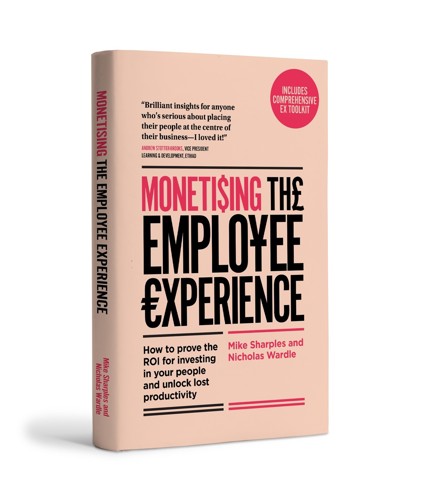Employee Experience strategy
At its simplest, a strategy is a plan of action designed to achieve a long-term or overall aim.
A business strategy, according to Michael D. Watkins, Professor at IMD Business School, is: "A set of guiding principles that, when communicated and adopted in the organisation, generates a desired pattern of decision making.”
It’s about how people throughout the organisation should make decisions and allocate resources in order accomplish key objectives. A good strategy provides a clear roadmap, consisting of a set of guiding principles or rules, that defines the actions people in the business should take (and not take) and the things they should prioritise (and not prioritise) to achieve desired goals. If you cover the Who, What, Why, When, Where How – you won’t go far wrong.
So, your Employee Experience (EX) strategy needs to reflect the above; keeping in mind that it should aim to advance the experiences employees have in order to boost their motivation and engagement in order to improve the culture and productivity.
The difference between strategy and tactics
In simplistic terms: strategy is bigger picture stuff, setting out how to achieve key objectives; whereas tactics are the activities you undertake to get you there. So, your EX strategy will define what you want to achieve and within it will be tactics such as improving the intranet, running pulse surveys etc.
How to write the Employee Experience strategy?
It’s important to have a clear definition of what you are trying to achieve, so you need to define the EX strategy. Your published EX strategy should include a high-level roadmap showing key objectives, milestones, and deliverables.
During the implementation phase, activities that align with the strategy should take priority and the EX strategy can often be a useful tool to help resolve any conflicts that arise along the way. You can read more about this here.
What is an Employee Experience Audit?
These are a deep exploration of what your people are thinking, feeling and doing; aimed at improving the working lives and performance of your employees.
They're likely to involve: talking to those responsible for EX and reviewing employee data and surveys, organisational aims etc., conducting employee interviews and surveys, recommendations for improvements and supporting with the strategy. You can read more about this here.
How to improve the Employee Experience?
To improve EX, organisations need to think like top-level sports teams and start thinking of their employees as prime athletes. This shift will enable employees to focus upon delivering upon expectations.
The more friction-free their experiences, the better. And as the people who actually do the work know and understand it the best, these are the people who should be involved in the creation of the experiences to understand how friction can be reduced and quality improved. You can read more about this here.
The Employee Experience Opportunity

To support organisations to become more knowledgeable and strategic about their EX, back in 2019 we created The Employee Experience Opportunity (EXO).
Background to the EXO
As far back as 2017, Forbes named creating a compelling Employee Experience (EX) as the No 1 HR trend. And yet, years later, the reality is that most organisations do nothing more than pay lip service to employees being their best asset. The global cost of unproductivity is said to be at a staggering $7 trillion. We felt something needed to change.
What is the Employee Experience Opportunity?
The Employee Experience Opportunity (EXO) is a movement with a singular mission: to give EX parity with Customer Experience (CX). Founded by Mike Sharples (Chief Experience Officer, Brand Experiences) and Nicholas Wardle (Head of Employee Experience, Brand Experiences), it launched in November 2019 with the support of the Institute of Internal Communication. Through free-to-use toolkits and an ROI calculator, the EXO is enabling EX practitioners to have more sophisticated and evidence-based conversations with their senior leaders about providing the budget and resources to enable their people to be productive.
What are the benefits of Employee Experience?
Effective EX benefits all stakeholders:
- the employees – who will benefit from an improved Employee Experience
- the customers – who will be serviced by happier and more productive employees
- the organisations – who will see a better return from their investment in people
What's currently going wrong?
Put simply, EX is not treated as seriously by senior leaders as CX. Think about it. If an organisation improves sales by 10% this would be a widely celebrated; if it decreased employee turnover by 10%, few would know. And yet, depending upon scale, the money saved by keeping employees in the organisation may be greater than the extra sales revenue – and retained, motivated employees are likely to contribute to sales.
Also, key touchpoints on the employee lifecycle are often managed by HR employees as an add-on to their core duties; so the work is often undercooked, either because the people responsible don’t have the time or don’t have the skills to bring about positive change. There are tech tools out there to support an effective EX, but few organisations are budgeting for them. EX is underfunded and undervalued. IT has made the case for investing in tech, Governance has made the case for investing in fail safe data processes; now it’s time for the case to be made for EX.
The Employee Experience Opportunity Roadmap

Ultimately, EX is about putting people at the heart of every organisation, because everyone matters at work. Effective EX leads to a more motivated, engaged and productive workforce… which will, ultimately, lead to a positive impact upon the bottom line.
The tools
The following tools are free to download and use:
Monetising the Employee Experience

The book was published in April 2021 with the aim of showing how to:
- Build the business case for investing in the employee experience
- Demonstrate why the ROI for EX is bigger and more easily realised than CX
- Understand the relationship between motivation and productivity
- Calculate how much more productive and profitable your organisation could be with a more motivated workforce
- Use the EXO Toolkit to deliver a great employee experience
The book is available on Amazon and via other booksellers.
Here’s what people are saying about the book:
With so many competing interests vying for corporate budgets, it is refreshing to see a compelling connection between employee experience and the bottom line. This book makes the business case in a way that should force every CEO to sit up and take notice. I thoroughly recommend it!
Bert P, Amazon customer
This is both an insightful and educational read. The motivation of an employee is key to any successful business and can be undervalued. This really identifies the benefits to both employer and employee. Mike Sharples and Nicholas Wardle should be saluted for providing knowledge and 'how' investing in an employee can make any business more productive and enjoyable.
Graham Hale, Amazon customer
Every business leader should read and fully digest this very well written book if they really want to understand that employees are their key to a successful company.
Amanda Holden, Amazon customer
Employee Experience audit, strategy and improvements in action
Theory is one thing, practice is another. Utilising our knowledge and experience of practical application, below is an illustrative case study of moving from audit to strategy to improvements.

The organisation: ACE (Artisanal Coffee Enthusiasts)
ACE are a growing high street coffee brand who desire to sit somewhere between the famous and popular chains (Starbucks, Costa etc.) and independents. They currently have almost 100 stores and a head office.
Undertaking the ACE Employee Experience Audit
ACE hadn’t undertaken an exercise like this before. They had an annual survey and the results were average. What disappointed employees is that they didn’t see the results and didn’t hear about any improvement initiatives off of the back of them. The leadership team wanted to indicate a change of approach and so promoted that the EX Audit was going to happen in advance and explained why.
Across two weeks, there was a pulse survey for all employees to complete, interviews with each of the eight Exec Team members, interviews with the eight people function directors and 10 focus groups covering employees from different departments – both head office and in-store. In addition, external reputation sites such as Glassdoor and Indeed were researched as well as other internal data sources.
Developing the ACE Employee Experience strategy
Before the strategy work began, it was decided to create an ACE EX Council, which included 12 Directors/Heads of from across the organisation. The Council would be involved in workshop sessions to help to define the strategy and then be an ongoing resource to support the core EX team (which consists of a Head of EX and an EX Manager) who leads the Council.
Following Brand Experiences’ BASICS methodology, there were three workshop sessions to support the creation of the strategy. The workshops, in addition to the audit data, provided the information to develop the strategy.
The way forward
A strategy document was published, which included the findings from the audit, a series of recommendations split into priorities, a clear roadmap, and a timeline.
Main themes: Eight main themes emerged from the research which were: Professionalism, Talent Attraction, Talent Retention, Wellbeing, Internal Communication, Recognition, Employee Voice and Culture.
Priority activities: Five were recommended, which were: Utilising the EXO Toolkit to create an Employee Lifecycle, Moments that Matter and Employee Journey Maps; Build the Employer Brand (to include introducing a Careers Portal and benchmarking the Employee Value Proposition), introducing mojo (to support with productivity efforts); delivering a more modern intranet; and introducing more Employee Voice mechanisms. Efforts related to these activities would be prioritised in year one.
Other activities: These included initiatives such as: career path mapping, introducing peer groups, Microsoft basics training, and increasing volunteering opportunities. Efforts related to these activities would be undertaken in year two.
You can read more on the Employee Experience here.


